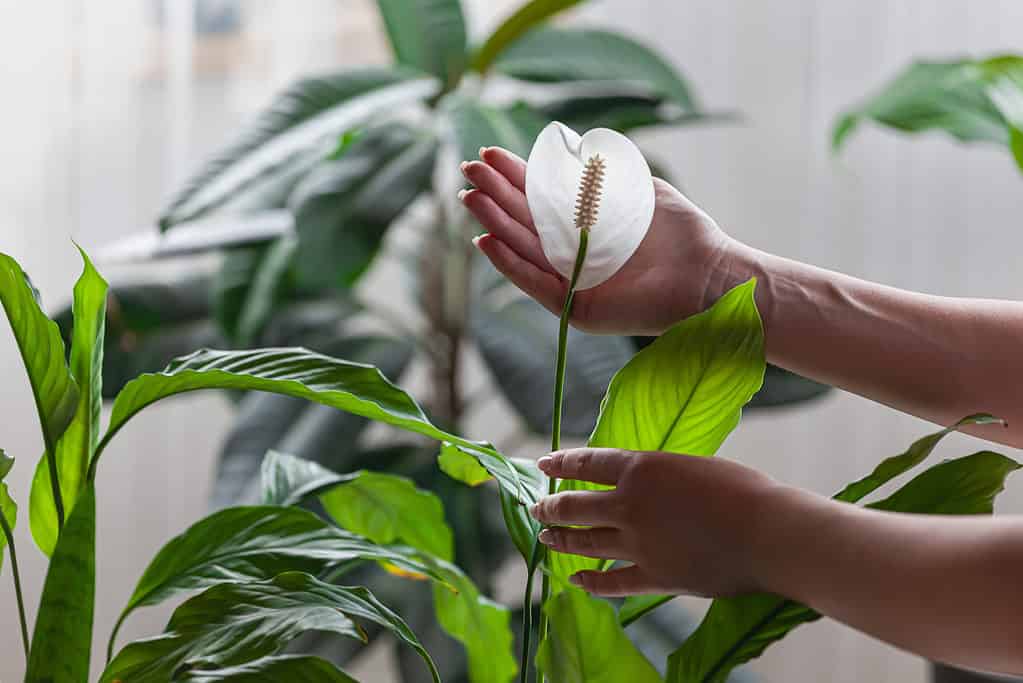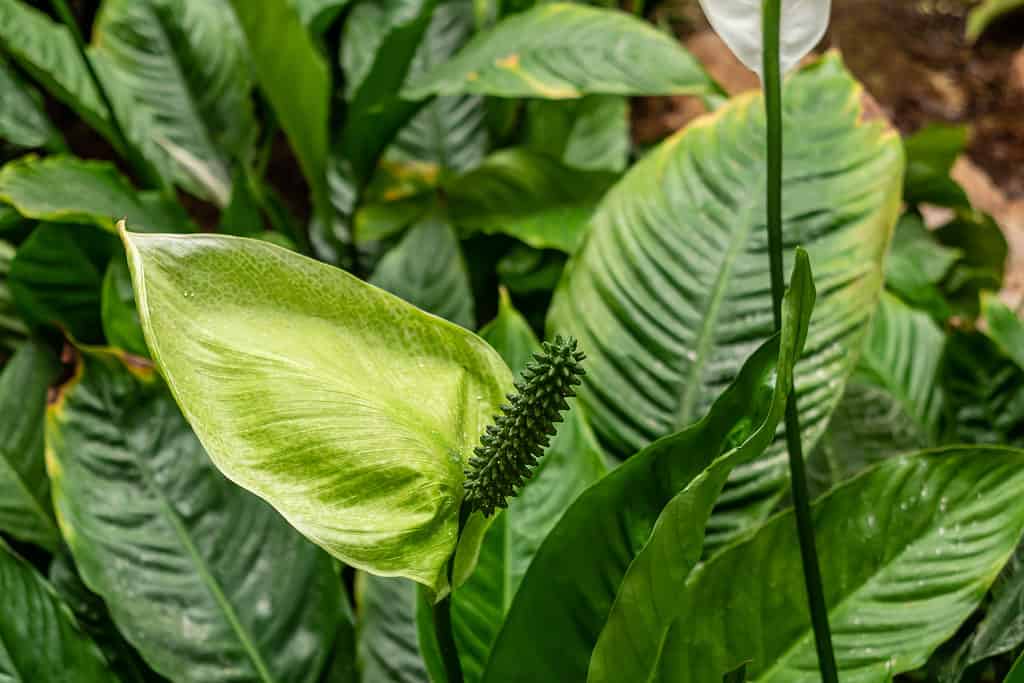Any type of flowering plant in the genus Spathiphyllum is known as the peace lily. This plant is an excellent houseplant that can endure very little light exposure and still manage to look absolutely stunning. They can withstand a certain amount of neglect, and they can let you know if their care isn’t up to par by dramatically drooping, making them excellent beginner-friendly plants. Peace lilies are also loved for their ability to filter harmful chemicals and pollutants from the air around them, which makes them useful for reasons more than just aesthetics.
In this in-depth guide, we’ll explore everything you need to know about this incredible tropical plant, from its appearance to its uses to its care.

Peace lilies (pictured) have a ton of symbolism due to their white, peaceful blooms.
©iStock.com/Galina Tolochko
The Meaning and Symbolism Behind Peace Lilies
One of the most popular houseplants in America is the peace lily. They have represented peace since ancient times, and now you may regularly see them at funerals or in hospital wards to help encourage hope and calmness. The plant’s intricate leaves, which resemble hands reaching upward, have earned it the nickname “the hand-holding flower.” The Latin word pax, which means “peace,” is where the name of this plant originates.
People almost everywhere around the globe relate this plant to calmness and tranquillity. White is commonly seen as a sign of peace, hence this plant has taken on this interpretation for itself. Its white blossom is a reminder of the white flags waved as a gesture of peace around the world. Read more about the symbolism behind peace lilies here.
Benefits of the Peace Lily
The Spathiphyllum plant is a popular choice for indoor plants because of the many health advantages it provides and the gorgeous touch it brings to rooms when kept indoors. Due to the stark contrast between its dark green foliage and white blossoms, this plant is well-liked for its aesthetics.
In addition to its attractiveness, this plant offers a ton of other advantages. One benefit that this plant provides for human health is that it filters the air. This plant can also protect you from harmful vapors emitted by home goods and appliances, such as acetone. Another great benefit of these plants is that they may be able to regulate the humidity levels in your house or place of business. Because of the tropical habitat in which they were born, they naturally absorb and enjoy moisture. And that’s not all this little houseplant can do! Read more about the benefits of peace lilies here.

The peace lily (pictured) can grow quite large, depending on its species and variety.
©iStock.com/perfectlab
Peace Lilies: Size
Not sure if the peace lily is the right indoor plant for you due to its size? Luckily, peace lilies vary greatly in size. In general, these plants may grow up to four feet tall indoors and six feet tall outdoors. However, there are several species and cultivars of plants in the Spathiphyllum genus, each of which has a distinct maximum size. Learn more about the various sizes and shapes of peace lilies here.
Do Peace Lilies Flower?
Yes, the Spathiphyllum plant flowers. In fact, it is a popular plant to keep at home due to its unique flowers. Surrounded by a petal-like white leaf that protects the buds within, the appearance of the houseplant’s flowers is unique and attractive.
For a variety of reasons, your plant might not bloom, and finding a solution is a challenge. The plant itself is a tropical, evergreen plant that thrives on the forest floor where it receives nutrient-rich soil, steady humidity, and filtered sunlight from beneath tree canopies. Duplicating similar conditions in your house can help your plant thrive and eventually blossom. Learn more about the life cycle of peace lilies here.

Potted peace lilies (pictured) are easy to cultivate, provided you give them the right lighting conditions.
©iStock.com/Anya Why
Peace Lily Cultivation 101: Quick Guide
If you want to grow a peace lily indoors, you’re in luck! Doing so is quite easy. Peace lilies are frequently utilized as indoor plants that are cultivated in pots because the majority of American climates are unsuitable for cultivating this plant outdoors. That being said, you may move your peace lilies outside for the summer. As the temperature decreases, it is wise to bring them back inside.
The best potting soil for peace lilies is rich, loose, and full of organic ingredients. Peace lilies need sunshine, but not direct sunlight. They like having lots of shade in the tropical conditions of their native habitat, so try to replicate that indoors for your potted plant. The amount of water this plant requires depends depend on the size of the pot and how rapidly the soil drains, but in general, water when the top inch of the pot’s soil becomes obviously dry. You can read more about growing a peace lily indoors here.
But what if you want to grow a Spathiphyllum plant outside in your garden? It’s not impossible, but it can be a bit difficult. In general, only USDA hardiness zones 10, 11, and 12 are suitable for growing peace lilies outside. You might not be able to grow your peace lilies outside directly in the soil if your hardiness zone is too chilly. To prevent harsh weather, you can move your potted plant inside during the winter in colder regions. You can read more about growing a peace lily outdoors here.
Peace Lily: Light Requirements
This plant is well known for flourishing in environments with little natural light, such as the typical house and workplace. The plant itself is frequently included among plants that can thrive in the absence of light. However, in order to survive, all plants require some level of light. This plant may grow well in low light, but in the absence of sufficient sunshine, it will not thrive or bloom. Light is necessary for a plant to grow steadily, even for those that don’t need a lot of it. Light starts the process of photosynthesis in plants. In order to manufacture the sugar it requires as a fuel source, the plant engages in photosynthesis. Thus, light is quite important! Read more about peace lily light requirements here.

The peace lily (pictured) needs regular watering in order to thrive.
©iStock.com/Liudmila Chernetska
Peace Lily: Water Requirements
This houseplant normally has to be watered once per week. How often you need to water this lovely plant might vary depending on its size, the kind of soil, the temperature, and the humidity. Knowing the best possible watering techniques is essential since these plants will blossom and thrive nicely when given the correct care.
If this plant is overwatered or underwatered, it will exhibit essentially the same symptoms. Drooping leaves are the most obvious and conspicuous symptom of drought stress and overwatering. The plant’s leaves may also become brown or even yellow from insufficient watering. The leaf edges tend to turn brown when the humidity is too low. You can learn more about how to properly water your peace lily here.
Peace Lily: Fertilizer Requirements
Without at least some fertilizer present in its soil, even a Spathiphyllum plant that is appropriately positioned and receives perfect light, temperature, humidity, and water levels will struggle to flourish. With the tiny levels of nutrients that are already present in the soil combination, certain plants can start to develop absolutely well. However, even for these unique plants, the soil mixture progressively loses nutrients over time, necessitating the sporadic administration of fertilizer.
Since these plants generate a lot of leaves, they often require fertilizers with a higher nitrogen concentration than phosphate and potassium. But an excess of nitrogen can also prevent these plants from flowering. Pick a 20-10-10 fertilizer so that a regular application won’t put the plant at risk of burning. Read more about how to fertilize your peace lily here.

The
Spathiphyllum‘Domino’ peace lily (pictured) is just one of many varieties of this plant.
©iStock.com/JOSE LUIS VEGA GARCIA
Peace Lily Varieties
There are over 40 different species of peace lilies in the genus Spathiphyllum, and over 100 different varieties of peace lilies. The most well-known and popular species would have to be Spathiphyllum wallisii.
The Araceae family includes this particular kind of peace lily. It is one of the more well-known and frequently used Spathiphyllum species for decoration and indoor plants. The peace lily is the common name, although it is also referred to as the white sail, Mauna loa, and spathe flower. The main native locations for this plant, which is endemic to Central America, are Venezuela and Columbia. In the tropical rainforests of the continent, it often grows in the wild beneath the eaves of big trees.
Due to this plant’s natural environment, home growers must be careful where they place the plant. The secret to keeping the plant alive in your house is to replicate its natural environment. The environment must be comfortable, partially shaded, and most importantly, out of direct sunlight. Learn more about Spathiphyllum wallisii here.
In addition to the popular Spathiphyllum wallisii species, there are also many popular varieties of peace lilies available. While some can resemble the classic Spathiphyllum fairly well, some of them vary very much from the original plant. All of the these varieties may, however, be grown successfully indoors.
Spathiphyllum ‘Allison’, one of the most popular Spathiphyllum cultivars, has a medium-sized group of dark green leaves. Rarer than other varieties, Spathiphyllum ‘Golden’ is prized for its ability to purify indoor air. The evergreen plant Spathiphyllum ‘Sensation’ has enormous, elliptical, dark green leaves that can form layers. The stem is 20 inches long when completely developed, and the white flower can be up to four inches broad. The dwarf “Petite” peace lily, which is indigenous to Southeast Asia, can grow to a height of around 18 inches. Learn more about some stellar peace lily varieties here.
Common Spathiphyllum Problems
Peace lilies are beloved among the indoor gardening community since they are not only beautiful but also very easy to care for. Just keep an eye out for the distinctive droop. They are quite tolerant plants and can let you know if they need some TLC by dramatically dropping their leaves. Brown foliage, dead leaves, pale leaves and spathes, and a lack of blossoming are additional common problems with peace lilies.
These issues have a number of remedies. In its natural habitat, the plant grows in a moist environment with dappled lighting. To replicate these conditions, place the plant in a location with medium-bright indirect light. You might also put it alongside other plants or use a humidifier to make the air around it more humid. Water the plant once the soil seems dry to the touch. Never let the soil completely dry out. You may also restore over-fertilized peace lilies by carefully cleansing the soil and using a well-balanced fertilizer product once every eight weeks or so during the late spring and early summer. Read more in-depth about peace lily problems, issues, diseases, and pests here.
Up Next:
- Easter Lily vs. Peace Lily
- The Best 10 Plants That Don’t Need Sun
- 10 Houseplants That Are Nearly Impossible to Kill
The photo featured at the top of this post is © iStock.com/dmf87
Thank you for reading! Have some feedback for us? Contact the AZ Animals editorial team.






